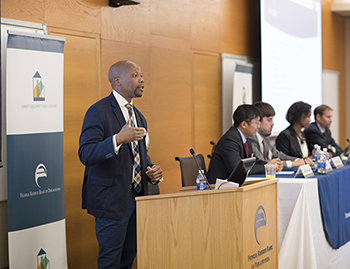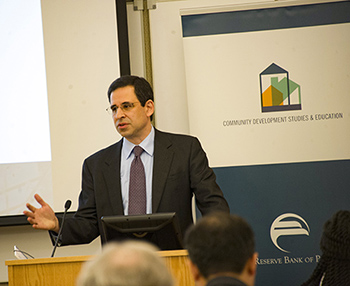Those with higher incomes are able to outbid low-income residents, which may lead to voluntary and involuntary displacement of these households. In low-income, center-city neighborhoods, this is particularly troubling, as these neighborhoods offer greater access to public transportation, social services, employment centers, and social networks. Displacement could force vulnerable households into less desirable and more impoverished neighborhoods.
These trends were described at the Research Symposium on Gentrification and Neighborhood Change, which was co-hosted by the Federal Reserve Banks of Philadelphia and Minneapolis on May 25, 2016, in cooperation with the Furman Center for Real Estate and Urban Policy at New York University and the U.S. Department of Housing and Urban Development. At the symposium, researchers and practitioners explored the causes, patterns, and consequences of gentrification; policy responses; and equitable development approaches. Selected papers from the symposium are available on the event website,1 and more papers will be published in the November issue of Cityscape. This article shares highlights from the symposium as well as policy, investment, and program solutions that communities can explore to address their unique local challenges.
Does Gentrification Matter?
While neighborhood change may be a certainty, thought leaders are increasingly asking whether gentrification’s effects on existing populations are necessarily negative. At the symposium, Lance Freeman, professor of architecture, planning, and preservation at Columbia University, showed that gentrification had no statistically significant effect on the probability that households move out of their neighborhood in the United Kingdom, although low-income households were more likely to move than higher-income households. The Philadelphia Fed's Lei Ding, a community development economic advisor, examined the financial health of residents in gentrifying neighborhoods and showed that residents’ financial health could improve if they are able to stay in a gentrifying neighborhood, but those who move out are more likely to end up in lower-income neighborhoods and experience ill effects on financial health. Jeffrey Parker, an urban doctoral fellow at the University of Chicago, found that most business owners in Chicago's Wicker Park neighborhood accepted gentrification because of the positive business gains and client growth, but believed it caused instability in their neighborhood. Rachel Meltzer, assistant professor of urban policy at The New School, added that existing businesses are no more likely to be displaced in gentrifying neighborhoods than in nongentrifying neighborhoods, although shifting consumer demand may attract outside investment, such as retail chains.

Lance Freeman, Professor, Columbia University
Despite the researchers’ findings, practitioners like Beth McConnell, policy director at the Philadelphia Association of Community Development Corporations (PACDC), are pushing back against some of these findings based on their experiences with residents on the ground. McConnell shared after the symposium that she has observed instances in which research is interpreted to indicate that gentrification and displacement are “less of a problem than what we observe on the ground; however, because something may not be statistically significant, it does not mean it doesn’t have an impact.” McConnell said that deeper collaboration between researchers and practitioners will help better identify indicators to examine in changing neighborhoods.
National and Local Responses
National and local responses to gentrification generally focus on equitable development measures or strategies such as providing greater access to subsidized housing and facilitating mixed-income development. Symposium practitioners highlighted efforts to preserve affordable housing, protect and effectively reuse vacant and blighted property, stabilize current residents, and support existing small businesses. Much of the conversation at the symposium centered on anti-displacement efforts in neighborhoods that have new development, public investments, and in-migration. Among national responses, Jeff Lubell, principal associate and director of housing and community initiatives at Abt Associates, described effective policy tools for increasing access to affordable housing in gentrifying areas, including property tax circuit breakers,2 expedited permitting for affordable housing developers, and the use of publicly owned land for affordable housing development. In addition to policy solutions, presenters discussed collaborative efforts between nonprofits, local governments, and philanthropic organizations to prevent displacement. For example, Kathy Pettit, senior research associate at the Urban Institute, spoke about the Turning the Corner initiative,3 which incorporates data collection and tracking with collective action in communities facing neighborhood change.

Eric S. Belsky, Director, Division of Consumer and Community Affairs, Board of Governors of the Federal Reserve System
The following sections present four additional local responses to gentrification and neighborhood change.
The Bay Area
One tool that can potentially bridge the gap between research outcomes and resident perspectives was presented by Karen Chapple, professor of city and regional planning at the University of California, Berkeley. Chapple discussed early warning systems for gentrification and the Urban Displacement Project policy mapping tool4 for communities experiencing gentrification pressures in the Bay Area. The project has partnered with community-based organizations to design case studies on gentrification and displacement based on data found through its analysis.
Washington, D.C.
In Washington, D.C., the Tenant Opportunity to Purchase Act (TOPA) program5 is an effective tool in preserving affordable rental units. TOPA allows the first right of purchase or refusal to current tenants before the owner of a tenant-occupied dwelling plans to sell or demolish housing. Oramenta Newsome, vice president of LISC DC, discussed the organization’s support of TOPA projects through technical assistance and financing. The D.C. Department of Housing and Community Development also administers a First Right Purchase Assistance Program, which provides down payment and purchase assistance, and a Tenant Purchase Technical Assistance Program, which assists eligible low- and moderate-income residents purchase their dwelling using TOPA. Newsome noted the successful use of TOPA to convert rentals into co-ops or condo units and added: “Not every tenant association needs to own their own building, but it is a viable tool to support a diverse income demographic in Washington.” For LISC DC, tools like TOPA address social and economic equity in a growing city with rising costs.
Philadelphia, PA
In Philadelphia, PACDC created the policy platform Beyond Gentrification: Toward Equitable Neighborhoods6 for the 2015 local elections. The platform gave those who are typically left out of economic development an opportunity to offer proactive steps and a vision for Philadelphia, informed policymakers and leaders on the role of community development in a growing city, and inspired continued conversations on equity. PACDC’s Beth McConnell commented: “Community development is being observed as a solution for gentrification. It has taken on a new and different relevance in a city of growth, where it was previously only associated with cities in decline. In this context, community development can spur new growth with equity.”
Minneapolis and St. Paul, MN
Jonathan Sage-Martinson, director of planning and economic development for the city of St. Paul, highlighted the Central Corridor Funders Collaborative7 strategy to prevent displacement along a new light rail line by investing in housing, small businesses, and job training. The collaborative is a collection of local and national funders that are invested in the equitable development of neighborhoods surrounding the new Metro Green Line. “The goal of the collaborative is to help existing businesses stay in place and to help people who live there afford to stay and make them want to stay there, with an emphasis on jobs,” said Sage-Martinson. One early goal of the collaborative was to create a strong local economy by supporting the 700 small neighborhood businesses that exist along the soon-to-be-built rail line. “The motto for these businesses was to prepare, survive, and thrive,” remarked Sage-Martinson. The collaborative devised a strategic plan to support the businesses during the two-year construction of the rail line and to prepare for a “new neighborhood reality” after its construction. The collaborative provided $4 million in forgivable loans to 215 businesses, technical assistance, joint marketing, and façade improvements.
A Story of Neighborhood Change
In his opening remarks, Eric S. Belsky, director, Division of Consumer and Community Affairs, Board of Governors of the Federal Reserve System, discussed how trends in housing demonstrate that the economic recovery has been uneven in urban neighborhoods. Homeownership has dropped and the supply of rental housing has tightened, resulting in surging rents and an increase in the number of cost-burdened households (those that pay more than 30 percent of their income on rent). In her welcome to attendees, Theresa Y. Singleton, vice president and community affairs officer of the Federal Reserve Bank of Philadelphia, asked the audience to ponder, “Is gentrification good or bad?” — a question her teenage daughter astutely posed and one that all symposium attendees struggle with. As researchers conduct more analysis on what is driving this change and what have been the effects, many practitioners are working to increase opportunities for both existing and new residents. Neighborhood change is inevitable; however, gentrification that furthers inequality by eliminating affordable housing options for low- and moderate-income households or concentrates poverty in distressed neighborhoods must be acknowledged and addressed.
The views expressed here do not necessarily represent the views of the Federal Reserve Bank of Philadelphia or the Federal Reserve System.
[1]To access videos, presentations, papers, and commentaries, visit the symposium website at www.philadelphiafed.org/community-development/events/2016/research-symposium-on-gentrification.
[2]According to the Center for Budget and Policy Priorities, property tax circuit breaker programs reduce property tax liability for households where property taxes exceed a defined income threshold through a refund of the excess taxes. For more information, visit www.cbpp.org/research/the-property-tax-circuit-breaker.
[3]For more information about the initiative, visit www.neighborhoodindicators.org/activities/projects/turning-corner-monitoring-neighborhood-change-action.
[4]For more information about this tool and to explore the maps, visit www.urbandisplacement.org/.
[5]For more on TOPA, see http://dhcd.dc.gov/service/tenant-opportunity-purchase-assistance.
[6]For more information on PACDC’s equitable development platform, see www.pacdc.org/EquitableDevelopment.
[7]For more information about the Central Corridor Funders Collaborative, visit www.funderscollaborative.org/.
